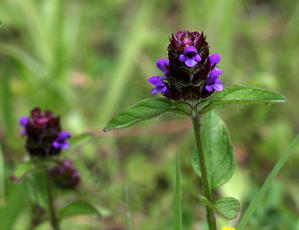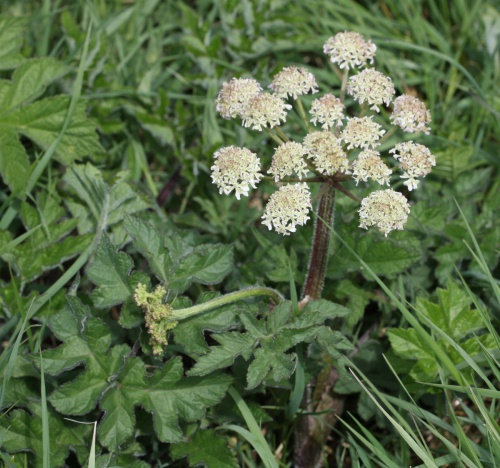
This verge, which is opposite Woodhouse Church, has over 40 species of wildflowers and plants, plus many animals visiting. Here are a few of the species recorded here. To find out more about the verge biodiversity project and to see a full list of all the known species visit the verge's Wild Place page on the NatureSpot website. Click on any header to visit the NatureSpot page for that species to find out more.
Red Clover
This handsome red flower is an important nectar source for bumblebees. Less common than White Clover and often associated with well-established meadow grassland.
How to ID: 3 hairy leaflets, often with white mark in the centre. Red/pink globular flowers.
Where to see it: Meadows, verges and other grassy habitats.
Similar species: Zig-zag Clover and Alsike Clover (more pink).
Autumn Hawkbit
Despite its name, it often starts blooming in June. It doesn't grow tall so favours short grass such as the edge of verges.
ID: Leaves with finger-like lobes. Yellow, dandelion-like flowers, usually with red streaks under the petals. Flower capsule tapers into the stem.
Selfheal
This is one of the few plants that can flower in mown grass. It can grow taller but when mown it adapts by flowering on very short stalks.
How to ID: Low plant with paired, usually hairy, leaves. The flowers are deep violet blue, set into a wine-coloured cylinder-shaped head.
Where to see it: Lawns, verges, short grassland.
Similar species: None
Hogweed
The large, white flower platforms provide one of the best food sources for pollinators, bringing a great opportunity to view visiting insects such as bees, beetles and hoverflies.
How to ID: Up to 2m tall. Flower 'umbels' to 20cm. Unique leaf shape.
Where to see it: Verges, hedges, rough ground - likes nutrient-rich soil.
Similar species: Giant Hogweed is similar but much larger (and quite rare).
Meadow Buttercup
The 'classic' meadow buttercup, growing to around 60cm.
How to ID: Typical yellow buttercup flower. Leaves are deeply divided and resemble large green snowflakes!
Where to see it: Established meadows.
Similar species: Creeping Buttercup (3 leaflets in a triangle) and Bulbous Buttercup (downward pointing sepals under the petals).
Yorkshire-fog
A very soft grass - covered in fine hairs (its scientific name 'lanatus' means woolly). Supposedly named because from a distance the flowering grass looks like low-lying smoke, such as that from Yorkshire factories.
How to ID: Stems soft and hairy. The flowers have a pink tinge when fresh, getting more straw-coloured with age. Base of the stems have red stripes.
Where to see it: Most grassland habitats.
Similar species: Creeping Soft-grass has similar flowers but hairless stems (apart from the hairy joints).
Chrysoteuchia culmella
These common moths are conjurers - flying in plain sight then 'disappearing'. They land on grass stalks and hug the stem with folded wings so are hard to see.
How to ID: Body length 12mm. Usually resting on plant stems. Wings with two angled cross-lines and a metallic golden fringe.
Where to see it: Any uncut grassland.
Similar species: There are several other 'grass moths' but all with different wing patterns.
7 Spot Ladybird
One of our larger ladybirds (up to 8mm), sometimes seen in huge numbers.
How to ID: Red with 7 black spots.
Where to see it: Everywhere! Feeds on aphids.
Similar species: Adonis Ladybird is also red with 7 black spots but is smaller and thinner.
Eriothrix rufomaculata
This is a common visitor to flowers in late summer and an important pollinator.
How to ID: A bristly black fly with prominent orange patches on the sides and a silvery face.
Where to see it: Plants with open, flat flowers, such as Hogweed, Yarrow and Dandelions.
Similar species: A few much rarer flies look similar.
Oak Bush-cricket
Bush-crickets are distinguished from grasshoppers by their ridiculously long antennae! This is an uncommon species which lives in trees and bushes where it hunts other insects.
How to ID: Around 15mm with antennae longer than the body. Pale green with a yellow stripe. Females have long upturned ovipositors - the egg-laying organ - at their rear.
Where to see it: Oak woodland but on any other nearby trees and bushes.
Similar species: The Speckled Bush-cricket doesn't have the stripe along its back. The Southern Oak Bush-cricket lacks wings.







